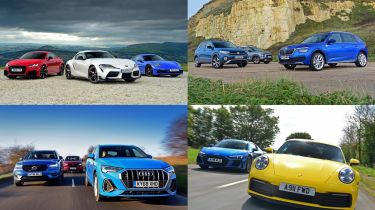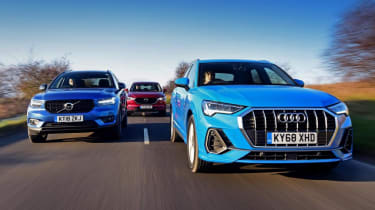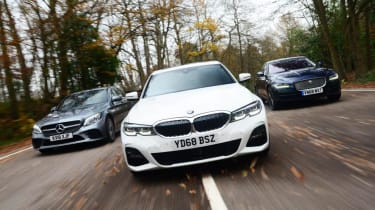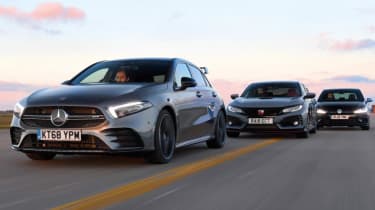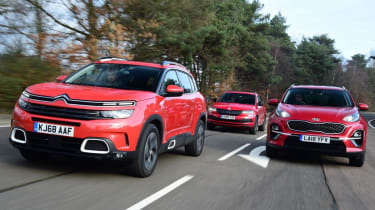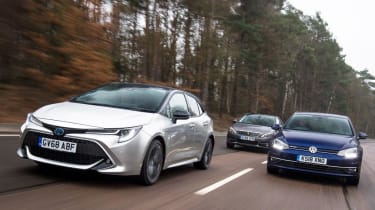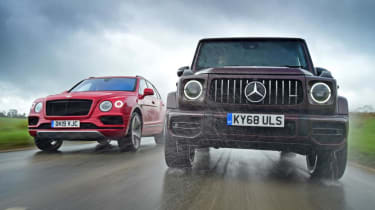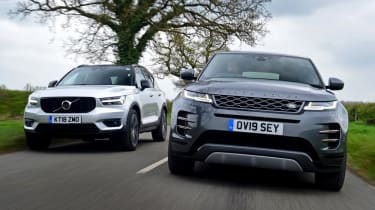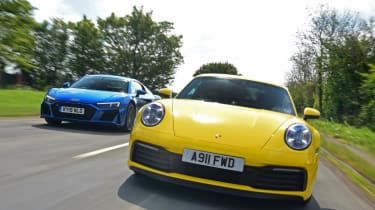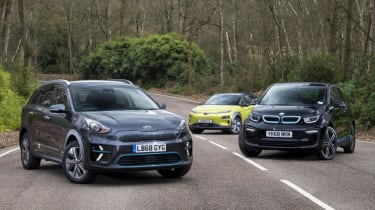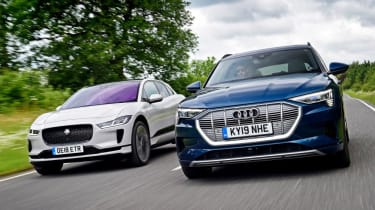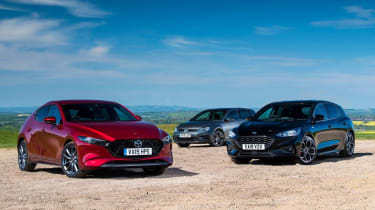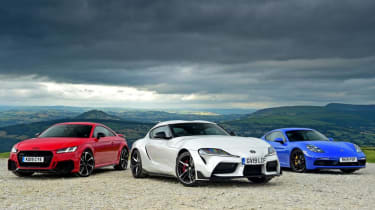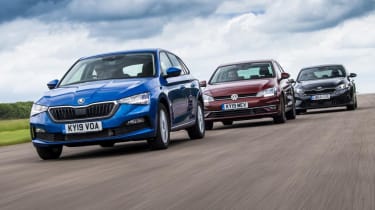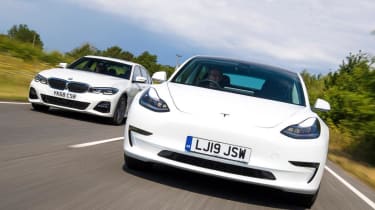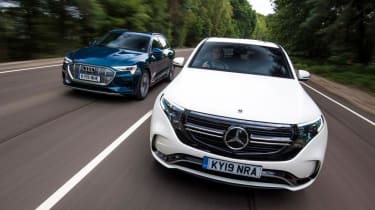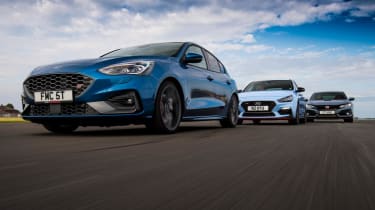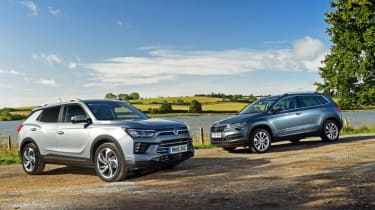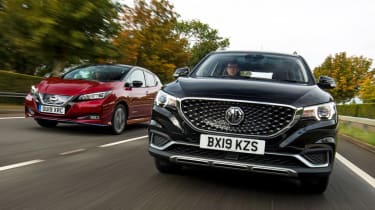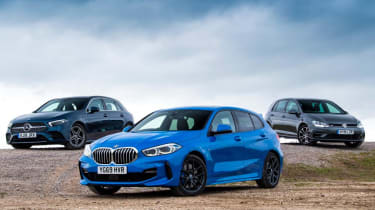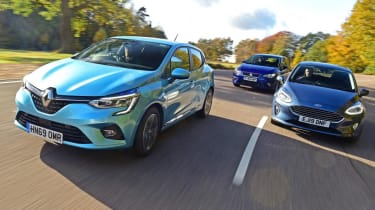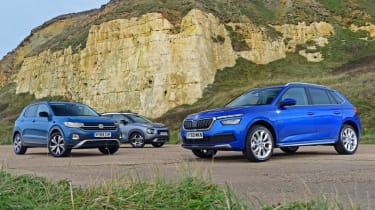Head-to-head: the best car group tests of 2019
We performed plenty of group tests in 2019, covering everything from superminis to supercars, but these are our favourites
There were plenty of new cars unveiled in 2019, but how many of them actually jumped to the top of their respective sectors? It’s our job at Auto Express to test each new arrival against the best in class to see if there’s a new king or not.
Each month we conduct a number of group tests, covering everything from city cars to luxury cars and SUVs to supercars. It’s this process that makes our group tests so valuable, as we are then able to recommend the best in class for each category.
So if you’re looking for a new car, but just can’t decide what to pick, a quick glance at our group tests page should help you decide. But before you head off to check them out, why not scroll down and have a read through our favourite group tests of 2019…
January
Latest Audi Q3 keeps its rivals at bay
Audi stole a march on its premium rivals when it first launched its Q3 crossover, but by the new year many premium competitors had caught up, so there was a lot riding on the all-new Q3. In petrol turbo form it fended off the challenge from one of our favourite small SUVs, Volvo’s XC40, to take group-test victory. The Q3 diesel would feature later in the year, but with less success.
BMW 3 Series vs Mercedes, Jaguar
A new BMW 3 Series is always big news. Early January saw us pitch the G20 model head-to-head with two of its closest rivals – the updated Mercedes C-Class and the Jaguar XE. We put every area of these upmarket saloons under the microscope to give the definitive verdict.
Despite a general trend towards SUVs even in this sector, junior execs are still huge profit-making products for their makers and so have to deliver across the board. With more infotainment and driving-assistance tech than ever, there were more opportunities for this trio to succeed – but more hidden traps for them to negotiate, too. All have traditionally excelled when it comes to the ride, handling and refinement balance, plus our 2.0-litre diesel test models offered decent efficiency. The 3 Series took victory due to an unbeatable blend of attributes that the Jag and Mercedes just couldn’t quite match. Its revised turbodiesel proved there’s life in this fuel yet and gave great performance and refinement, the updated infotainment excelled, it rode and handled like a small, sporty saloon should, and the improved packaging meant it was even more practical. Extra driver tech made it a more intelligent, more connected machine as well.
It wasn’t all perfect for the seventh-generation 3 Series, though. Throughout this year the BMW design team has been a little wide of the mark with the new models it has released, and given that this is one of the more conservative cars to come out of Munich, the 3 Series’ design still wasn’t to all tastes. However, this is very subjective – in every measurable area, the BMW triumphed over or at the very least equalled its rivals to pull off a convincing victory.
We said: “The 3 Series is king of the compact exec class. It sets a new benchmark for handling, but balances this with comfort and refinement. It’ll also be cheaper to run, boasts more practicality, and an updated interior and infotainment cement its first-place finish. In almost every area it betters its rivals, with advanced tech keeping up with buyers’ demands.”
That last point was key, and even though the BMW would face tougher challenges throughout the year, a 320d that joined our test fleet in April showed the car has the staying power to succeed and keep the 3 Series flame alight.
February
Merc A35 AMG vs hot-hatch rivals
The hot-hatch market is full of fine cars, so Mercedes’ new AMG A35 had a tough task when it took on the Honda Civic Type R and VW Golf R. The A35 proved accomplished, but it lacked flair and fun compared with the Honda, and proved pricier yet no better than the Volkswagen. Its straight-line performance was strong, though, while its interior was easily the classiest.
New Citroen C5 Aircross is good, but still can’t beat Karoq
Citroen’s Aircross SUV tag was applied to an all-new model with the C5 Aircross, the brand’s full-size family SUV. It arrived with the funky, fresh styling that Citroen is known for and a soft suspension that aimed to deliver decent comfort.
However, the soft set-up meant the car was wallowy and crashy, so it didn’t drive with the composure, comfort or precision of the best cars in this class. Plus its 1.2-litre engine – peppy enough in the smaller C3 Aircross – proved a little flat in this larger, heavier car. The C5 did nail practicality, though. Its interior featured plenty of tech, and versatile seating meant that owners could prioritise passenger or boot space.
Our test showed that there was nothing drastically wrong with the C5 Aircross, but also that there was nothing stand-out about it that demanded attention either.
In a class where every last little area has to be heavily optimised for a car to succeed – as it is with the Skoda Karoq that took victory – the C5 Aircross fell a little short.
March
All-new Corolla faces up to Golf, 308
As well as replacing the Auris in the range, Toyota introduced a new chassis, powertrain and infotainment for its Corolla family hatch. Hybrid power remained, but sophisticated suspension meant the Corolla rode and handled as well as the Golf, the best car in the class up to this point in the year, and put it ahead of the Peugeot 308.
However, it lost out on practicality due to the hybrid system spoiling boot space a little. Plus Toyota failed to improve enough in an area where it’s always been weak: infotainment. Without the latest smartphone-compatible tech, it lost ground to the VW.
April
Mercedes G 63 vs Bentayga
This pairing faced off against each other to vie for the crown of the flashiest 4x4 on sale. Both used turbocharged V8s, cost around £150,000 and packed performance, tech and style. The British Bentley emerged victorious over the German brute, but not by much, because the G 63’s character is so unique that it’s a rare moment of indulgence to drive it in today’s electrified world.
Evoque vs Volvo XC40
When the original Range Rover Evoque launched, it helped to secure Land Rover’s financial future, shifting more than 800,000 models. So with a grey cloud hovering over the brand in 2019 related to Brexit uncertainty, the second-generation car had big shoes to fill – but it slotted in beautifully, taking up the original car’s mantle as one of the best small premium SUVs on sale.
In popular D180 form it beat the Volvo XC40 in our first twin test. While the Evoque was a little pricier, Land Rover pushed finance deals from the start, and that’s where the Evoque made more sense against its Swedish counterpart. Add in greater practicality, excellent quality and superb tech, and the Evoque had the sector sewn up.
Items such as Land Rover’s ClearSight tech – which uses cameras to ‘fill’ blind spots – and a digital rear-view mirror proved superbly simple solutions and incredibly effective tech that nosed the Evoque ahead of its competition.
But it was the foundations laid by the new PTA platform, the more refined 2.0-litre diesel engine and the supple but controlled suspension that cemented victory. The Evoque has a level of ride quality befitting of the Range Rover badge but it’s still fun to drive for an SUV.
May
Porsche 911 and Audi R8 face-off
The launch of a new Porsche 911 is always a big deal. In the model’s 56-year history there have been only eight generations – and this 992-codenamed version proved to us that it’s the most technologically advanced yet.
An updated turbocharged engine still featured at the rear of a wider chassis that used more aluminium than ever before, while the interior came in for a massive overhaul.
The 992 arrived at the same time as the facelifted Audi R8, which still turns up its nose at turbocharging with its glorious 5.2-litre naturally aspirated V10, and faced the Porsche in our exclusive twin test. Here, both cars proved stunning to drive for different reasons, but it was the 911 that showed it was the more complete sports car. Despite a lower power output, it out-performed the R8, out-cornered it, rode better and offered more practicality – and the new technology it offered sealed the deal.
Yet the swollen size and new assistance systems that forced some mechanical and electronic changes over its predecessor meant the 911 felt more remote than ever. Make no mistake, it’s still the best sports car on sale, but with the base Carrera and manual models not launching until later, this was a hint at the 911’s future development path.
e-Niro is a bright spark among small EVs
Electric cars were among the dominant themes of 2019, so we pulled together three small, affordable EVs to find out which was best. The Kia e-Niro took victory, beating its mechanically and electronically similar cousin, the Hyundai Kona Electric, by virtue of greater practicality and more range – the latter being key in any EV. In fact, the Kia is one of the best cars we’ve tested all year.
June
Audi e-tron vs Jaguar I-Pace
At the time, the I-Pace was still our Car of the Year – and it’d faced little opposition since taking the crown nearly 12 months prior to this test against the e-tron. Few new EVs had been launched, let alone with the Jaguar’s premium aspirations, power, performance and price.
All that changed when the Audi EV arrived, although the I-Pace showed just how far ahead of the curve Jag was with its first electric car. Stronger efficiency than the e-tron proved more practical from a driving and range point of view, even if the Brit EV wasn’t as roomy inside. It also rode slightly better than the Audi and blitzed its rival for both performance and handling. The brand showed it understands EVs, too, with the electric car-specific elements a little better calibrated than Audi’s.
The Jag’s cabin might not have been as techy or well built, but it wasn’t far behind. Thanks to its bespoke EV platform, the I-Pace showed established rivals have a little way to go when it comes to making class-leading EVs, and that models adapted from existing architectures still have a few issues. However, both cars proved so convincing with their genuinely usable battery range that they could act as your only car in the majority of situations.
This pairing also highlights that the infrastructure lags behind the tech. Many companies are doing great work to kickstart the electric revolution, with BP Chargemaster at the fore, yet other charge providers such as Ecotricity proved unreliable. There were no complaints about either the Audi or the Jaguar’s ability, though. Both did well in this fiercely contested twin test, but the I-Pace came across as the better EV, and that’s why it took top honours.
Mazda 3 vs Golf vs Focus shoot-out
The mainstream family car market is one of the most crowded, with tough competitors at every turn – and the new Mazda 3 had to face two of the strongest when it met the Ford Focus and VW Golf back in the summer. The Mazda 3 has always handled well, so the Focus represented the dynamic benchmark, while the Golf was the yardstick by which the Mazda’s practicality, tech, quality and affordability would be judged.
The Japanese car came out with its head held high. It steered, rode and handled with as much class as the Ford, while the interior quality surpassed the Golf’s, helped by much-improved infotainment. However, the Mazda 3 suffered a little in practicality and all-round usability, so still had to give best to the VW. Nevertheless, it had returned as a very accomplished car.
July
Toyota Supra vs TT and Cayman
Few sports cars have been as hotly anticipated as the all-new Toyota Supra, and we put it through the full Auto Express road test in July. A few issues surrounding the link with BMW aside, the car impressed immensely and easily outshone the Audi TT RS, but Porsche’s 718 Cayman S still proved too strong a package to overcome. However, the Supra scored a solid second on merit.
New Skoda Scala tests its mettle against Golf and Ceed rivals
Fresh from its win in our New Car Awards, the Skoda Scala took on two of the toughest challengers in the family car class, facing off against the venerable Volkswagen Golf and the latest Kia Ceed. But in 1.0 TSI petrol form, the Scala showed why it was an award-winner, with an unbeatable blend of practicality and technology at an affordable price.
Budget is key in this class, and Skoda once again proved that its value-focused offerings resonate with buyers. The Scala drove as well as the Golf, and although it didn’t quite stack up to the VW when it came to material quality, its price was low enough for it not to matter.
It also had the measure of the Kia for standard kit, with SE trim featuring all the toys a mid-spec family hatch really needs.
The Golf was toppled, the Scala reigned king. But with a new eighth-generation VW on the horizon and set to battle the Skoda in 2020, will we be writing the same this time next year?
August
Tesla Model 3 edges out 3 Series in executive saloon test
The Tesla Model 3, Auto Express Car of the Year, had yet another big test in August as it took on one of the best in the business – the BMW 3 Series in 320d form – to see whether an electric car could genuinely be a more viable alternative to one of the best premium diesel saloons around. The result went the Tesla’s way, but the verdict wasn’t quite that simple.
On balance the EV took it, but if you use your exec saloon to cover long distances regularly then the BMW is still the better bet. However, for most users most of the time, the Tesla proved that it’ll offer enough flexibility from its 55kWh battery, serving up a claimed 254-mile range, so some owners might only need to charge once a week. And even long journeys aren’t too much trouble if you can hunt down a Tesla Supercharger or a DC rapid charger – the Model 3 being the first Tesla to be fully compatible with the latter. With the charging infrastructure growing, it’s becoming less of an issue, if not a totally avoidable one.
Thanks to its instant torque and urgency off the line the Model 3’s performance outstripped what the BMW could offer, while its annual running costs also far undercut the 320d’s. This was a main driver in the Tesla’s victory, since this gulf was so big that it’s hard to ignore in a type of car that many buy for business use. For those looking at this pairing with a view on company car tax, the Model 3 won hands down – and that was with BiK tax charged at 16 per cent. It drops to zero from the next tax year, where electric vehicles such as the Model 3 will have an even bigger advantage over their combustion-engined counterparts.
Dynamically it didn’t quite ride or handle with the BMW’s balance, but Tesla’s engineers have really clued into how to use the electric motor to help the car carve through corners. And while the suspension wasn’t quite as absorbent, it delivered plenty of composure and comfort. Yet with strong infotainment (the BMW was a particularly tough test for the Tesla here) and an improved interior with a decent amount of space and a versatile boot, our Car of the Year showed why it won our votes back in July.
Mercedes EQC vs Audi e-tron in electrifying battle of premium EVs
The Mercedes EQC sits on another combustion-engined car platform turned into an EV, and it took on the Audi e-tron, which conforms to a similar recipe. But, the Merc mustered stronger efficiency – critical to maximise range.
Add to that a smoother ride, and the Merc just edged the Audi, even if it isn’t quite as practical. Both showed they have beautifully built, high-quality interiors, too, and so deserve their premium status and justify their fairly lofty price tags. However, this test highlighted that with cars such as the Tesla Model 3 and updated Model S, the premium EV sector had already moved on yet another half step by the time the EQC arrived.
September
Ford Focus ST hot hatch versus Hyundai i30 N and Honda Civic Type R
The last few years for Ford’s performance division have shown it hit a rich vein of form, with the likes of the GT supercar and Fiesta ST hot hatch – and it was no different when the Focus ST arrived earlier in the year.
It landed with plenty of tech, including adjustable driver modes that altered the adaptive dampers, the limited-slip diff, the throttle response and the engine note, not to mention optional extras such as launch control. However, it did this in a less overawing way than the i30 N it went up against. This hot hatch offers myriad settings, all tuneable independently as opposed to the Ford’s choice of four pre-set modes.
The ST’s fast steering, grippy but playful chassis, and its torquey engine meant it matched our benchmark, the Civic Type R, for performance, yet it just lacked a little of the Honda’s engagement and the shift quality of its beautiful six-speed box.
But the ST ticked all the other hot-hatch boxes; it was practical, reasonably efficient and had enough kit to feel hi-tech.
October
SsangYong Korando vs Skoda Karoq
That SsangYong’s all-new mid-size SUV, the Korando, could be mentioned in the same breath as a class-leader like the Skoda Karoq showed how far the Korean brand had come – and a lot of that stemmed from the firm’s investment in its infotainment system. A big touchscreen with the latest phone compatibility and a digital dash helped offset the coarse engine and baggy ride.
MG ZS EV vs Nissan Leaf
Britain’s best affordable EV is a crown not without competition, and the MG ZS EV faced one of its toughest contenders to that title in the form of the Nissan Leaf.
But it emerged victorious thanks to its lower price tag yet a bigger battery that provided a better range. The two cars were closely matched on performance, with both offering similar power, but the ZS EV used less electricity.
The MG didn’t ride or handle brilliantly, while there were a few niggles that needed to be ironed out (the charging door flap was one of them), but the tech on offer for this price was hard to ignore.
BMW 1 Series vs Golf and A-Class
Plenty of new BMWs were launched this year, but perhaps the most interesting was the 1 Series. The model had undergone a total revamp and was barely related to the car that came before it, so we put BMW’s all-new family hatch up against two key rivals.
There were two natural contenders: the Mercedes A-Class and the Volkswagen Golf. The former is an obvious competitor, with advanced in-car tech, downsized turbo petrol engines and an automatic gearbox in a premium-looking and feeling package. The Golf has been a strong performer since launch, and despite a replacement having been unveiled since, it was still a worthy rival.
These challengers were even more closely matched to the new 1 Series because it sends its power through the front wheels. Despite this, as we found out, the BMW retained its place as the best-handling car in the class, but it was also the most comfortable model in the test.
These key features, plus a hi-tech and upmarket cabin, low running costs and decent practicality, all combined to hand the BMW the win, with the comfortable, good-to-drive Golf second and the tech-filled Mercedes third.
November
New Clio trounces Fiesta and Ibiza to take supermini honours
New superminis are always big news because they’re among the biggest-selling cars in the UK, thanks to buyers loving how they bring practicality and efficiency into a small, affordable and easy-to-drive package. So we were excited to see if the all-new Renault Clio would be able to take on two talented rivals: the Ford Fiesta and SEAT Ibiza.
With the Fiesta being Britain’s best-selling car and the Ibiza trading blows with it in various Auto Express group tests over the past few years, the Clio really had its work cut out in this competitive class – but the French car impressed first time out and drove away with the win.
There were several key areas that we focused on in this test: value for money, running costs and technology, with plenty of importance also placed on handling, ride comfort, practicality and safety. The fifth-generation Clio showed a big improvement in every area to take class honours.
With value being such an important factor, the Renault’s low price and good level of standard equipment put it in a strong position before we’d even driven it. Once we got inside it was clear that the Clio would also beat its rivals on cabin quality, with a new infotainment system that’s up to date and more usable, and comparable in-car tech.
The all-new interior impressed our testers, and with standard equipment including AEB, sat-nav, cruise control, LED lights and parking sensors even on our low-spec Iconic test car, it was very well equipped for the cash.
While the Clio’s rear-seat space left a bit to be desired, there was more room in its boot than in either the Fiesta or the Ibiza, and therefore plenty of practicality; 391 litres is more than enough for daily duties. And when we got the Renault out on British roads it became clear that the new French supermini also had the ride and handling balance to steal a win from its rivals. While the Fiesta is still the best-handling car in its class and delivers plenty of fun, and the Ibiza has a great engine and gearbox, the Renault rides more smoothly. For most buyers, this matters more, and it’s all the more impressive when you realise that the Ford and SEAT are by no means poor in this category.
The Clio’s 1.0-litre three-cylinder engine was more disappointing. It fell behind the Ford and SEAT in our acceleration tests, and felt a bit underpowered, but at least it was quiet and refined. This wasn’t enough to take away from the Renault’s appeal, though, and its good driving position helped add to its appeal.
All three of these models returned nearly identical fuel economy on test, so costs came down to finance and list price – and with the established models costing more than the newcomer, the Clio was able to hop ahead of the SEAT and finish in first place.
Skoda Kamiq vs T-Cross and Aircross
The Skoda Kamiq shot straight to the top of the ultra-competitive compact SUV class when we tested it for the first time this year against the VW T-Cross and the Citroen C3 Aircross.
The Skoda’s hi-tech infotainment set-up and long list of standard kit helped it to secure the win. Under the skin the Kamiq uses the same platform, engine and gearbox as the T-Cross, and both SUVs were closely matched. There was plenty of space inside both, and a big boot, while the quiet but punchy 1.0-litre engine also proved a winner.
The C3 Aircross might have come third, but its cabin design and big, flexible boot drew praise.
Which was your favourite group test of 2019? Let us know your thoughts on the comments section below…
Review of the Year 2019

• Best car news stories of 2019• Best car reviews of 2019• Best car group tests of 2019• Best long-term tests of 2019• Best motoring features of 2019• Best car videos of 2019• Best motorsport stories of 2019• Our highlights of 2019
Find a car with the experts
